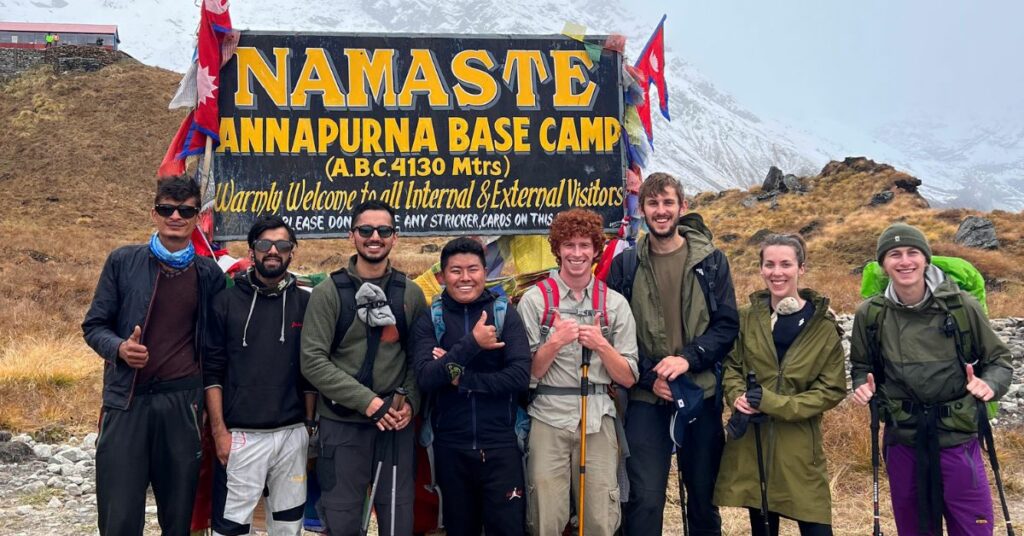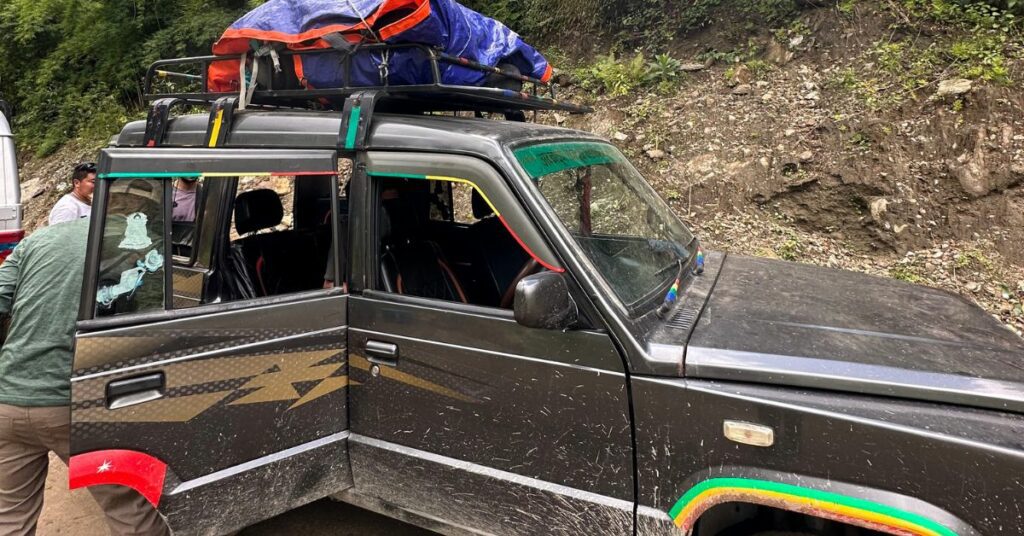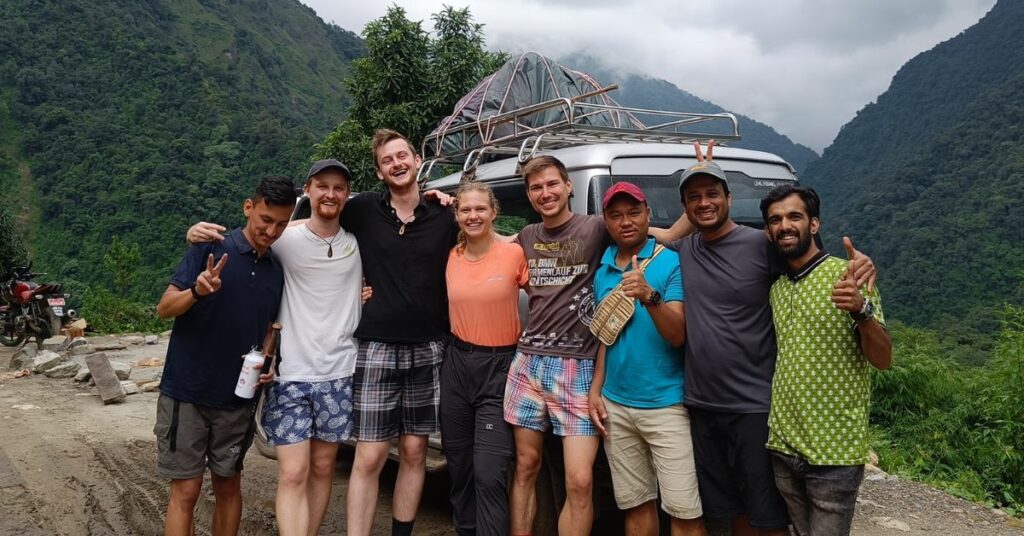How Much Does It Cost to Trek ABC? 2025/2026
The cost of the Annapurna Base Camp (ABC) trek is influenced by several factors, including the season, duration, transportation choices, and personal preferences. Trekkers may more efficiently manage their budget for this amazing Himalayan journey if they are aware of these expense components. It is very important to analyze all the factors carefully in order to trek to ABC on a minimum budget, too. For instance, trekking during peak seasons, such as spring (March to May) and autumn (September to November), tends to be more expensive due to higher demand for accommodation and services.
In terms of transportation, public transportation is more affordable than private vehicles. Additionally, if you want to stay on a tight budget, then there are budget-friendly teahouses, and also you can carry essential gear instead of renting which can somehow reduce your expenses. By carefully considering these factors, trekkers can enjoy the beauty of the Annapurna region without overspending.
The Cost to Trek Annapurna Base Camp
Trekking to Annapurna Base Camp (ABC) is a dream adventure for many. Despite this, it’s essential to understand the costs involved before setting off. The Annapurna Base Camp (ABC) Trek is one of the most popular trekking routes in Nepal. It is located in the heart of the Annapurna region. The trek takes you through lush forests, picturesque villages, and majestic mountain landscapes, culminating in the stunning Annapurna Base Camp, which sits at an altitude of 4,130 meters (13,550 feet). This trek offers a unique blend of natural beauty and cultural immersion, making it a must-do for adventure enthusiasts.
Why Knowing the Cost Is Crucial?
When you start your journey to Annapurna Base Camp, it’s important to have a clear understanding of the costs involved. Trekking in Nepal is a significant investment, and without proper planning, unexpected expenses can quickly add up. Although the price of the journey varies according to the facilities and services you choose, it usually delivers great value for the one-of-a-kind experience it gives. Understanding the cost of the trek helps you budget effectively, ensuring that you have a seamless and stress-free experience, both on the trail and back home.
Key Factors Influencing the Cost of Trekking to ABC

The cost of trekking to Annapurna Base Camp (ABC) can vary significantly depending on several factors that shape your overall experience. From the season you choose to trek to the type of services you opt for, every decision can impact your budget. Let’s dive into the key factors that influence the cost of your ABC trek and how you can navigate them to suit your budget.
Trekking Season
The cost of trekking to Annapurna Base Camp is influenced by the time of year you choose to trek. The ideal seasons for trekking are spring (March to May) and autumn (September to November). However, trekking during these peak seasons can be more expensive than during the off-season. This is due to higher demand for permits, accommodation, and guide services.
Duration of Treks
The duration of the trek also affects the overall cost. While most trekkers take around 7 to 10 days to complete the trek, a longer trek may involve additional accommodation, food, and transportation costs. But you can also take a short route to Annapurna Base Camp, which will take 5 days. So, if you are planning a shorter trek, your costs may be lower, but it is essential to have enough rest on limited rest days and possible delays during the short trek.
Type of Trekking Package
There are different types of ABC trekking packages available, ranging from budget-friendly options to more luxurious all-inclusive tours. You can also take a more luxurious package, like staying in a luxurious hotel will cost more than staying in a normal teahouse during the trek. So, budget treks typically include basic accommodation and meals, while higher-end packages may include premium lodging, private transport, and guided services. Budget trekking packages include packages like the Short 5-Day Khopra Danda Trek or Sikles Kapuche Lake Trek. At the same time, Ghorepani Poon Hill Trek or Mardi Himal Trek are the standard trek packages that provide a balance between comfort and affordability. For more premium experience, you can have a helicopter tour to ABC.
Independent or Guided Trek
An independent trek is usually cheaper as you don’t have to spend on the guides and porters. Your costs will include only personal expenses like what you spend on accommodation, permits, food, drinks, and flights. Although it will be cheaper to trek alone, it is always safest to trek with a guide or in a group.
The guided trek is the safest option that will provide you with a great lifetime experience. Being in a group you can explore and know about the hidden trails. Also, having an experienced and trusted travel operator can help you navigate the route efficiently and comfortably. You can have an enjoyable and memorable journey to ABC.
Cost Before the Trek Starts
Before starting your Annapurna Base Camp (ABC) trek, there are several expenses to consider:
Flights to Nepal: International flight prices vary based on departure location, typically ranging from $600 to $1,200. If you fly domestically within Nepal, a flight to Pokhara from Kathmandu costs around $100 to $150.
Hotel in Kathmandu/Pokhara: Staying in Kathmandu or Pokhara before the trek can cost between $20 and $150 per night, depending on the level of comfort and services you choose. Budget accommodations are available for lower prices, while luxury hotels cost more.
Breakdown of Annapurna Base Camp Trek Costs
Annapurna Base Camp is a popular trekking route in Nepal, offering stunning views of the Annapurna mountain range. The cost of the trek can vary depending on factors like the duration, level of comfort, and whether you trek independently or with a guide. Below is a breakdown of the typical costs involved:
Permits and Fees
One of the first costs you’ll encounter when trekking to ABC is the permits. For trekking to ABC you will require two permits with you.
TIMS (Trekkers’ Information Management System)
The Nepal Trekking Agencies’ Association is in charge of running TIMS. In order to control the trekking business and ensure the safety of trekkers, it collects information on them. This permit costs around NPR 1,000 (USD 9) for SAARC trekkers and NPR 2,000 ( USD 18) for foreign trekkers.
ACAP (Annapurna Conservation Area Permit)
This permit is required for all trekkers and costs around NPR 2,000 to NPR 3,000 (USD 25). The Annapurna Conservation Area is responsible for promoting and safeguarding the Annapurna’s protected area through the ACAP.
Transportation Costs

Getting to and from Annapurna Base Camp involves transportation expenses, primarily for getting from Kathmandu to Pokhara, the gateway city to the trek. Transportation is one of the significant part of the overall cost for the ABC trek. Especially since you need to travel between Kathmandu and Pokhara and then to the trek starting point (usually Nayapul or Phedi). You have options to drive to Pokhara:
- By Bus: A standard bus ride from Kathmandu to Pokhara costs around NPR 600–1,500 (USD 6–15). If you want the cheapest ride, then you can take a local bus that will cost 7 USD.
- By Private Vehicle or Jeep: This option offers more comfort but comes at a higher price, typically NPR 8,000–15,000 (USD 80–150) for a one-way trip.
- By Flight: If you prefer to fly, the domestic flight from Kathmandu to Pokhara can cost around NPR 3,000–5,000 (USD 30–50).
Once you reach Pokhara, you’ll need to travel further to the trek’s starting point, usually by jeep or bus, which can add an additional NPR 1,000–2,000 (USD 10–20). You can also take a taxi, which will cost 3 to 8 USD.
Accommodation Expenses
Along the Annapurna Base Camp trek, accommodation is available in teahouses, which are basic but comfortable lodges offering a bed and basic amenities. The cost of accommodation can vary depending on the altitude and location.
- Lower Altitudes (Pokhara to Chomrong): NPR 200–400 (USD 2–4) per night.
- Higher Altitudes (Machapuchare Base Camp, ABC): NPR 500–1,000 (USD 5–10) per night.
You have to pay higher rates for accommodation at higher altitudes due to fewer options and limited supply. Also, it will cost from NPR 200-300 (USD 2–3) if you want WiFi for unlimited. And if you want a hot shower, then it will cost NPR 100, depending on the hotel you choose.
Food and Drink Costs
Food is a basic human need that you will require to energy while trekking. Meals along the trek is generally simple, consisting of traditional Nepalese dishes like dal bhat (lentil soup), momos (dumplings), and fried rice. The average cost per meal is:
- Breakfast: NPR 200–500 (USD 2–5).
- Lunch: NPR 400–700 (USD 4–7).
- Dinner: NPR 400–800 (USD 4–8).
As you ascend, prices tend to rise due to the increased cost of transporting food and supplies to higher altitudes.
For drinks, you can have options:
- Bottled Water: NPR 100–300 per liter( higher at altitude)
- Tea/Coffee: NPR 100–200 per cup
- Soft Drinks: NPR 200–400
Additional Costs to Consider for the ABC Trek
While the Annapurna Base Camp (ABC) Trek is relatively affordable compared to other treks in Nepal, there are several additional costs that trekkers should consider when planning their budget. These costs can add up, so it’s important to account for them to avoid high costs.
Guide and Porter Fees
Hiring a guide or porter is optional, but it can significantly enhance your trekking experience. A guide can provide insights into local culture, navigate the trail, and ensure your safety. Please do remember to hire a licensed and experienced guide. A guide typically costs between NPR 3,000–5,000 (USD 30–50) per day. This will include their salary, accommodation, travel insurance, and food.
Porters are the people who will carry your bags, which can ease the physical strain of the trek. A porter typically carries around 20 kg of weight. It would be helpful if you got your porter so you could enjoy your trek fully without any disturbance. They charge around NPR 2,000–3,000 (USD 20–30) per day.
Gear and Equipment Rentals
You can rent most of the necessary trekking gear in Kathmandu or in Pokhara. Common rentals include trekking poles, sleeping bags, jackets, and boots. Trekking poles will be helpful when you are climbing at high altitudes, they will support your back. Sleeping bags will ensure you have a good sleep. Waterproof jackets and sturdy boots are essential for the trek.
- Trekking Poles: NPR 100–300 (USD 1–3) per day.
- Sleeping Bags: NPR 200–500 (USD 2–5) per day.
- Trekking Boots: NPR 300–800 (USD 3–8) per day.
Insurance and Emergency Costs
Although the Annapurna Base Camp is less risky, you also have to walk daily for 4 to 5 hours. It’s essential to have comprehensive travel insurance that covers medical emergencies, evacuation, and trip cancellations. There may be a chance of altitude sickness or any other medical emergencies. So this document will be required to cover your medical expenses. Insurance costs vary, but it generally range from USD 50–100 for a basic policy for the trek duration. It is a little costly but very valuable.
Miscellaneous Costs
Other than basic needs, you may encounter some extra costs while trekking. It includes tips for the guide or porter, or you may like the Nepali local crafts and herbs found in villages. You may also prefer hot showers, for which you have to pay. Charging your electric devices will cost you a certain fee.
- Tips: Tipping is customary in Nepal. It’s recommended to tip your guide and porter at the end of the trek, typically around 10% of the total trek cost.
- Souvenirs: Small items like local crafts, postcards, and Himalayan herbs can be found in villages along the route.
- Hot Showers: Depending on where you stay, you may need to pay for hot showers, which typically cost NPR 100–500 (USD 1–5).
- Charging Cost: There is no regular supply of electricity in some regions. So to charging your devices will cost NPR 200- 500 (USD 2–5).
How Much Does it Cost to Go to Annapurna Base Camp: A Detailed Breakdown
| Expense | Approximate Cost |
| Flights (Kathmandu- Pokhara) | USD 30–50 |
| Permits | USD 45–55 |
| Food and Accommodation | USD 30 per day |
| Travel Insurance | USD 170 |
| Guides and Porters | USD 30–40 per day |
| Trekking Equipment | USD 200 – 500 if new |
| Miscellaneous | USD 200– 300 |
Is the Annapurna trekking expensive for Nepalis and foreigners both?

The cost of trekking to Annapurna Base Camp (ABC) varies for Nepalis and foreigners. Foreigners generally have higher expenses due to trekking permit fees, which will cost around NPR 3,000 forthe Annapurna Conservation Area Permit (ACAP) and NPR 2000 for the Trekkers’ Information Management System(TIMS) card. In contrast, Nepali citizens pay significantly lower permit fees. Additionally, accommodation and food prices remain the same for both, but foreigners may spend more on guides, porters, and travel insurance. Overall, while the trek can be costly for foreigners, Nepalis can complete it on a much lower budget.
Tips to Minimize Your Annapurna Base Camp Trek Costs
The Annapurna Base Camp (ABC) Trek can be done on a budget without compromising the experience. By making smart choices and planning ahead, you can significantly reduce your expenses. Here are some practical tips to minimize your ABC Trek costs:
Travel During Off-Peak Season
The best way to lower your overall costs is to trek during the off-peak season (June to August). Prices for accommodation, permits, and transportation tend to be lower, and there are fewer trekkers, allowing for a more relaxed experience.
Opt for Budget Trek Packages
If you’re on a tight budget, then you have to choose a trusted trekking agency that offers budget-friendly packages. These may not include luxury lodges or private transport, but will ensure a comfortable and affordable trekking experience. At Mountain Routes, we have different trekking packages for the Annapurna Region, ensuring you have a safe and peaceful trekking experience.
Use Shorter Routes to ABC
You can complete your trek in a short days and reduce the cost and time of trekking to ABC. The Jhinu Danda to ABC route (5–6 days) starts with a jeep ride from Pokhara, skipping Poon Hill and reducing expenses. The Siwai route (6–7 days) also shortens the trek by avoiding Nayapul. For a faster return, a helicopter ride from ABC cuts costs on accommodation and food. These shorter routes help minimize expenses while still offering the stunning Annapurna experience.
Travel in a Group
Joining a group trek can significantly reduce costs. Group trekkers share guide and porter fees, as well as transportation costs, which can make the overall cost much lower compared to a solo trek.
Book in Advance
Booking your trek, transportation, and accommodation in advance can help you secure the best prices and avoid last-minute price hikes. Early bookings often come with discounts or fixed rates, especially for transportation and guided treks. During peak seasons (Spring: March-May and Autumn: September–November), teahouses, guides, and transportation can get fully booked. Booking early ensures you get your preferred options. With everything pre-arranged, you can focus on enjoying the trek rather than worrying about logistics.
